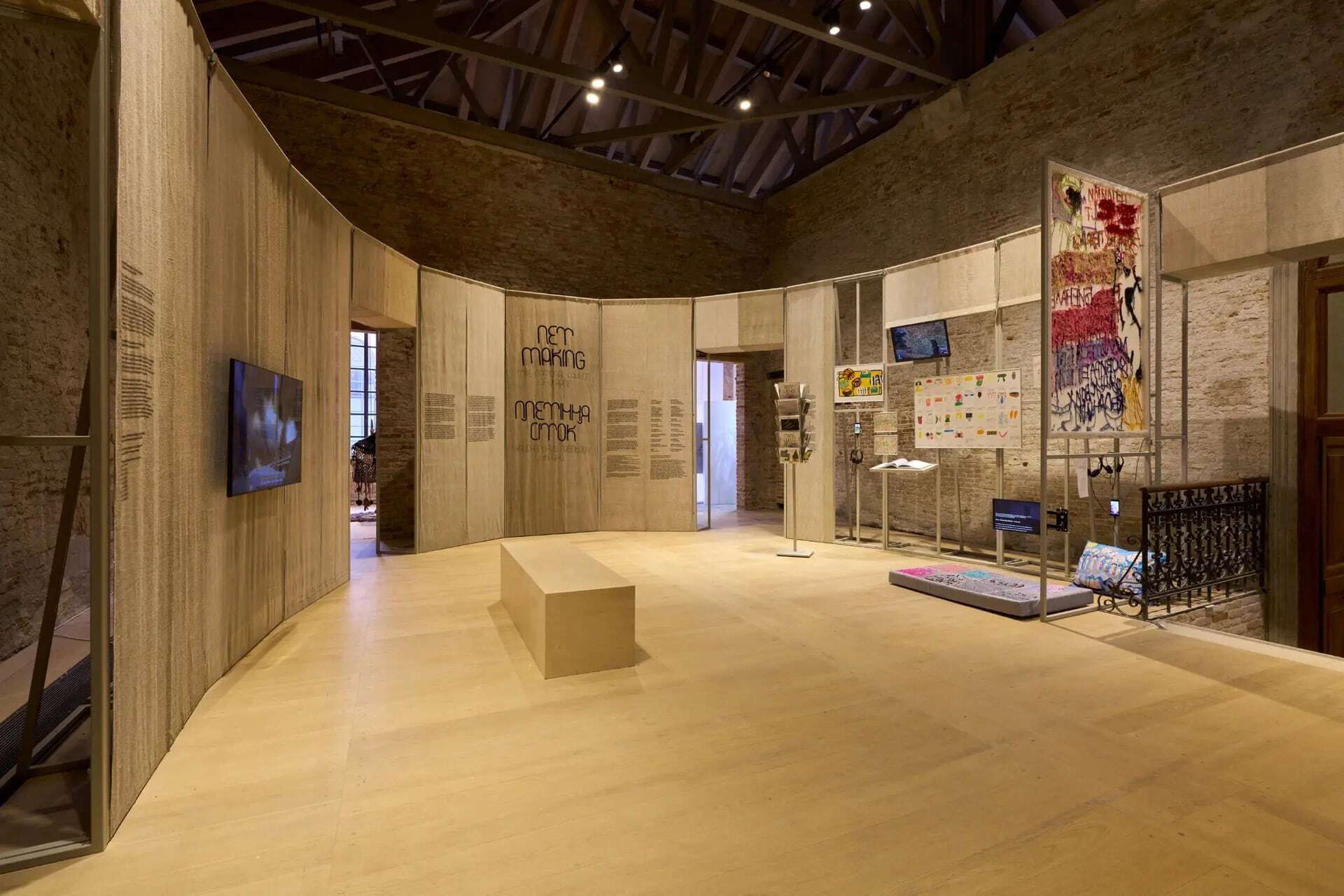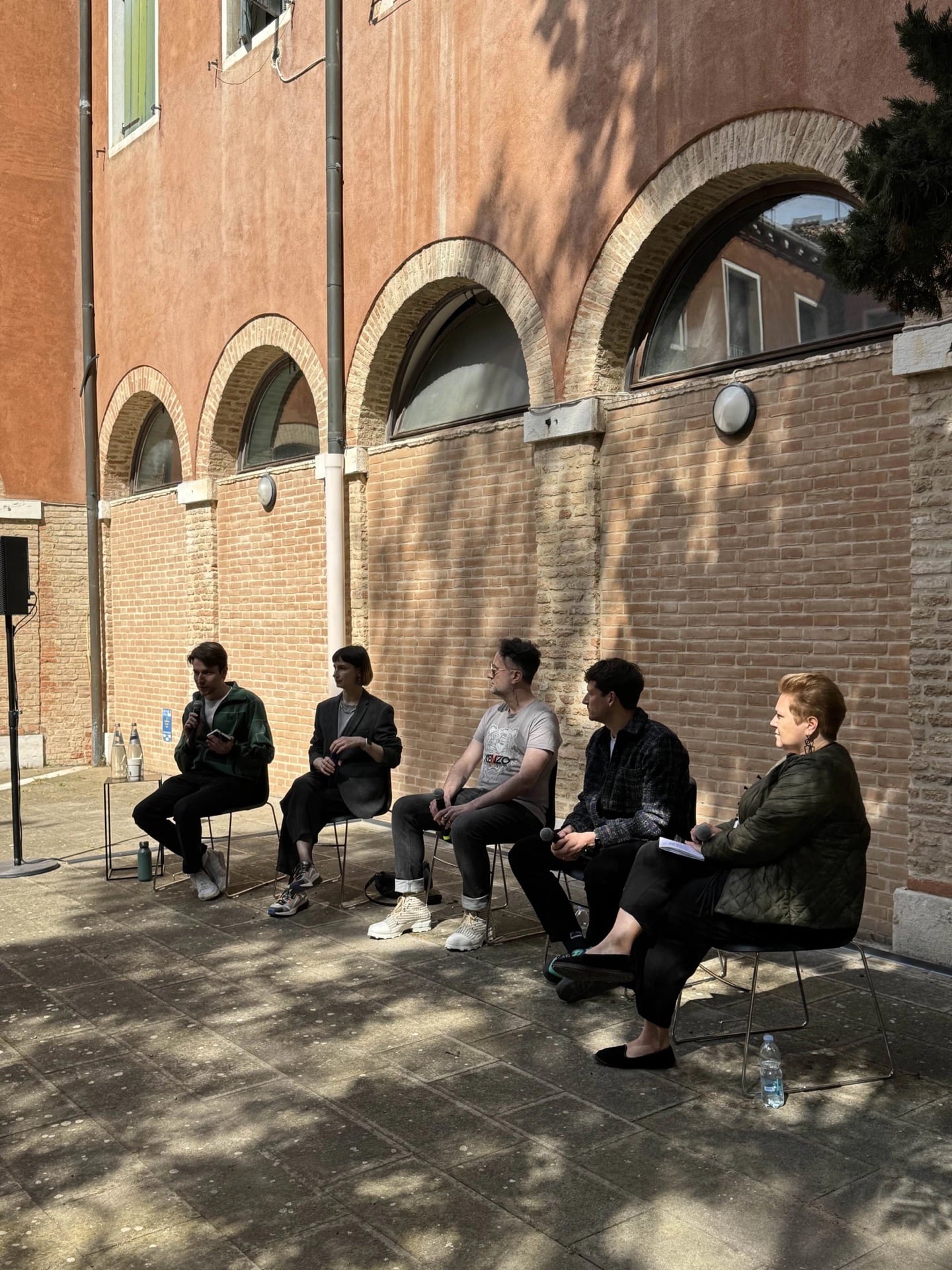ZMINA: Rebuilding - Net Making: A brief look at Ukrainian pavillion at the 60th Venice Biennial

The ZMINA: Rebuilding grant programme supported the national Ukrainian pavilion at the 60th Venice Biennial, namely the Net Making project. The Biennale took place from 20 April to 24 November 2024.
%20Opening%20Speeches%20-%20Ukraine%20Pavilion%20-%20Venice%20Biennale%20(APRIL%202024)%20%C2%A9Rob%20Battersby%208__resized.jpeg)
The project is based on the practice of weaving camouflage nets, which has spread in Ukraine since 2014, when Russia annexed Crimea and occupied the eastern territories. Ukrainian soldiers went to defend Ukrainian lands from Russian invaders. A strong volunteer movement began across the country - people helped in any way they could, collecting money, clothes, first aid kits, and gifts for the holidays. It was also at this time that people also began to unite to weave camouflage nets - special textile covers used to camouflage and protect equipment, weapons, engineering fortifications and military locations. It spread very quickly. People found various places to weave nets: school gyms, museums and libraries, and other available buildings. People taught themselves weaving techniques, collected fabrics, and began to understand the types of nets needed depending on the season, landscape, and purpose.
In February 2022, with Russia's full-scale invasion of Ukraine, the Ukrainian volunteer movement, including self-organised camouflage netting groups, took off with renewed vigour. Nets are being woven all over Ukraine, with volunteers exchanging and assisting across borders. The public sector has proved to be extremely powerful and effective, and the volunteer movement has become a real phenomenon.
“The weaving of nets is symbolic and, simultaneously, a very real embodiment of horizontal organisation and collective action. As a direct action, it forms the protection of Ukrainian fighters and the deception of the enemy, yet net weaving has also turned into a group therapeutic practice that offers a sense of belonging. This feeling of usefulness enables socialisation and dulls the feeling of guilt that haunts all Ukrainians,” the exhibition booklet states.
The project of the Ukrainian national pavilion at Venice works with the metaphor of weaving nets and collects various experiences of Ukrainians, fragment by fragment. “This Net Making project is about forging connections in times of crisis and attaining the strength to speak through unity with others.”
Stories should be told and shared in order to preserve the memory and to show individual painful experiences to foreign audiences, which cannot be compared to the media portrayal and information about the Russian-Ukrainian war.
%20Opening%20Speeches%20-%20Ukraine%20Pavilion%20-%20Venice%20Biennale%20(APRIL%202024)%20%C2%A9Rob%20Battersby%2014__resized.jpeg)
“Artistic practices are an anessential alternative: here, the bearers of experience can turn into co-authors and form expressions themselves. We paid much attention to the actual process of joint work and co-creation. Each artist has interacted with diverse communities in a different way, helping to create a form and support for sharing their experiences through artistic practices.”
The project featured four artworks that took a different approach to the topic, highlighting different approaches to collectivity and interaction with others.
Katya Buchatska
Best Wishes (2024)
paintings, drawings, embroidery, video, texts, etc.
Participants:
Anastasia Averina, Chef Georgy, Iryna Holoborod’ko, Yevhen Holubentsev, Oleksii Denysenko, Vlada Dyka, Olia Zholobetska, Nastia Kravchuk, Daryna Malyuk, Oleksii Ovdiienko, Artem Oliinyk, Valentyn Radchenko, Anna Sapon, Oleksandr Steshenko, Varya Shyshlova
Katya Buchatska is a Ukrainian artist living and working in Kyiv. She says that in the first week of Russia's full-scale invasion, she and her colleague Olga Shyshlova resumed and made daily online classes at the inclusive art ‘Workshop of Possibilities’, where Katya has been working for eight years. Every day they gathered, chose new topics and painted things that brought them back to their routine. “Of course, we were all traumatised by reality. But we relied on these attempts to act normally, preserving our previous knowledge of the world. Life continued, days stretched on, birthdays came,” she describes in the booklet.
Gradually, the artist began to notice that the usual language around her was changing, that certain phrases were no longer appropriate and were acquiring new meanings that had been hidden before. She felt that the language no longer depended on us.
“The sense of redefining linguistic reality was reinforced by the characteristic of neurodivergent people to change these clichés, use them freely and/or hyperbolically, and alter conventional forms of communication,” described the artist.
She decided to try to capture a certain language that is sometimes felt in the texts of greetings, wishes and reflections around the holidays: “How exactly do you wish for a person in the middle of a disaster? What words should we use? And can our wishes change our future?”
%20Opening%20Speeches%20-%20Ukraine%20Pavilion%20-%20Venice%20Biennale%20(APRIL%202024)%20%C2%A9Rob%20Battersby__resized.jpeg)
Andrii Dostliev, Lia Dostlieva
Comfort Work (2023–2024)
video
This work shows videos of what appear to be Ukrainians talking about their experiences. However, the truth is that for this work, the artists found professional actors from the US and EU countries to play Ukrainian refugees in a stereotypical way, as people outside of Ukraine imagine them. Before doing so, the artists had many conversations with Ukrainians abroad with refugee backgrounds about their experiences: what societies expected of them and what they found unexpected. They were also involved in the filming to help the actors convey emotions in the best way possible. “The videos were created with a European viewer in mind, who might be comforted by seeing a selection of what has been determined as comfortable refugees,” the artists mentioned.
Oleksandr Burlaka
Work (2024)
textile, metal structure
Oleksandr Burlaka, a Ukrainian architect and artist who works with photography, research and installation, has created a textile wall of three artworks. The works include dozens of canvases of homespun fabric from the 1950s and 1960s from different regions of Ukraine. This type of fabric, which is still often kept in many families, is the last link in the traditional home production of flax and hemp. The time spent at work refers to the basic metaphor of weaving. After all, weaving represents hope and is also a therapeutic collective practice that distracts and helps to focus. This work tells of personal experiences and shared disasters.

Andrii Rachynskyi, Daniil Revkovskyi
Civilians. Invasion. (2023)
video
This project uses videos shot by civilians to document the full-scale invasion. Since 24 February 2022, we have seen a large amount of material: images and videos taken by journalists, professional photographers, and the military. The authors of the project focused on lesser-known videos that were found using various social media algorithms.
“We watched thousands of videos, found vloggers who ran channels about living in war conditions, made a selection of footage, and edited it into a film. The video work follows a certain story structure: it starts with the realisation that a full-scale invasion has begun and attempts to understand how to survive it; continues with the risks experienced by civilians during hostilities, episodes of damage and destruction of housing; and ends with moments of some of the filmmakers dying, and what happens to the bodies of civilians after death,” say the authors of the project.
They searched for videos on social media and YouTube using keywords. Often, they found channels of individuals with a small number of subscribers, which gradually changed from the author's content on everyday life to recording the war: staying in basements, evacuation from the occupied territories, trying to survive and at least somehow set up basic necessities during the fighting, videos of shelling, explosions, mutilation and burials of civilians. On some of the channels, the videos have stopped being updated and the fate of their authors is unknown.
Videos by civilians were chosen, not by military. One of the important topics was the study of what happens to the bodies of civilians after death in combat zones. “How and where are burials made? Where are the bodies transported, in what pits are they buried and how long can they remain unburied? We conducted a large study on burials and the destruction of cemeteries as a result of hostilities.”
This video footage is of great value, as it preserves eyewitness accounts of the war that can be deleted and destroyed at any time. This year's Biennale had a strong exhibition, which shows how important it is to bring people together. It is these connections that strengthen stories, help preserve memory, and create high-quality long-term narratives that will reverberate in society for a long time to come.
Author: Anna Siedykh
ZMINA: Rebuilding is a project co-funded by the EU Creative Europe Programme under a dedicated call for proposals to support Ukrainian displaced people and the Ukrainian Cultural and Creative Sectors. The project is a cooperation between IZOLYATSIA (UA), Trans Europe Halles (SE) and Malý Berlín (SK).